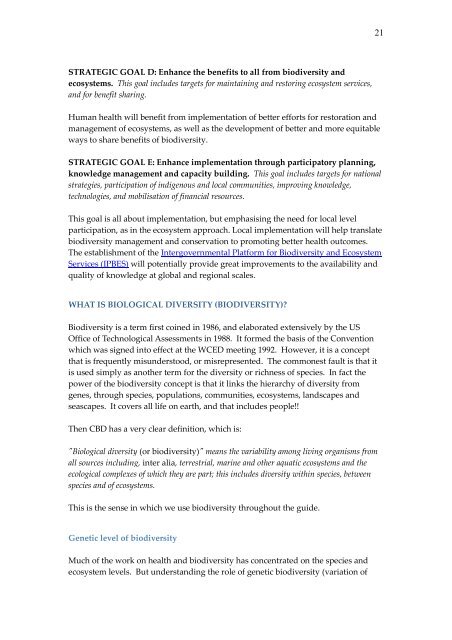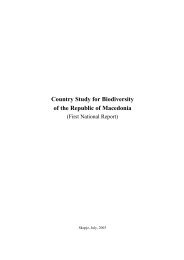Healthy Planet, Healthy People Guide - Convention on Biological ...
Healthy Planet, Healthy People Guide - Convention on Biological ...
Healthy Planet, Healthy People Guide - Convention on Biological ...
Create successful ePaper yourself
Turn your PDF publications into a flip-book with our unique Google optimized e-Paper software.
STRATEGIC GOAL D: Enhance the benefits to all from biodiversity and<br />
ecosystems. This goal includes targets for maintaining and restoring ecosystem services,<br />
and for benefit sharing.<br />
Human health will benefit from implementati<strong>on</strong> of better efforts for restorati<strong>on</strong> and<br />
management of ecosystems, as well as the development of better and more equitable<br />
ways to share benefits of biodiversity.<br />
STRATEGIC GOAL E: Enhance implementati<strong>on</strong> through participatory planning,<br />
knowledge management and capacity building. This goal includes targets for nati<strong>on</strong>al<br />
strategies, participati<strong>on</strong> of indigenous and local communities, improving knowledge,<br />
technologies, and mobilisati<strong>on</strong> of financial resources.<br />
This goal is all about implementati<strong>on</strong>, but emphasising the need for local level<br />
participati<strong>on</strong>, as in the ecosystem approach. Local implementati<strong>on</strong> will help translate<br />
biodiversity management and c<strong>on</strong>servati<strong>on</strong> to promoting better health outcomes.<br />
The establishment of the Intergovernmental Platform for Biodiversity and Ecosystem<br />
Services (IPBES) will potentially provide great improvements to the availability and<br />
quality of knowledge at global and regi<strong>on</strong>al scales.<br />
WHAT IS BIOLOGICAL DIVERSITY (BIODIVERSITY)?<br />
Biodiversity is a term first coined in 1986, and elaborated extensively by the US<br />
Office of Technological Assessments in 1988. It formed the basis of the <str<strong>on</strong>g>C<strong>on</strong>venti<strong>on</strong></str<strong>on</strong>g><br />
which was signed into effect at the WCED meeting 1992. However, it is a c<strong>on</strong>cept<br />
that is frequently misunderstood, or misrepresented. The comm<strong>on</strong>est fault is that it<br />
is used simply as another term for the diversity or richness of species. In fact the<br />
power of the biodiversity c<strong>on</strong>cept is that it links the hierarchy of diversity from<br />
genes, through species, populati<strong>on</strong>s, communities, ecosystems, landscapes and<br />
seascapes. It covers all life <strong>on</strong> earth, and that includes people!!<br />
Then CBD has a very clear definiti<strong>on</strong>, which is:<br />
"<strong>Biological</strong> diversity (or biodiversity)" means the variability am<strong>on</strong>g living organisms from<br />
all sources including, inter alia, terrestrial, marine and other aquatic ecosystems and the<br />
ecological complexes of which they are part; this includes diversity within species, between<br />
species and of ecosystems.<br />
This is the sense in which we use biodiversity throughout the guide.<br />
Genetic level of biodiversity<br />
Much of the work <strong>on</strong> health and biodiversity has c<strong>on</strong>centrated <strong>on</strong> the species and<br />
ecosystem levels. But understanding the role of genetic biodiversity (variati<strong>on</strong> of<br />
21

















